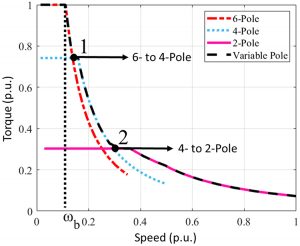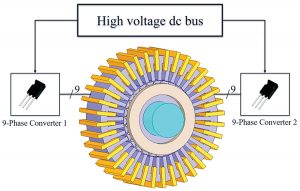Variable-Pole Induction Machines for Electric Vehicles
Elie Libbos with adviser A. Banerjee
High power density, high efficiency, inexpensive drivetrains operating over a wide speed range are critical for traction applications. An induction machine (IM) offers a cost-effective, rugged and reliable alternative to permanent magnet solutions. Figure 10 shows the torque-speed characteristic of a conventional fixed-pole motor designed at six-poles.

Figure 10: Torque–speed characteristics for two-, four-, and six-pole configurations of a given IM as obtained from finite-element analysis. The machine is nominally designed for six poles. ωb is the six-pole base speed.
Beyond the speed ωb, the torque capability of six-poles rapidly drops as the motor flux is weakened due to the finite inverter voltage constraint. A possible solution is to trade off the machine power density and efficiency with a wider speed range. However, sacrificing power density and efficiency is not a desired a solution. An alternative solution is to vary the IM magnetic pole count on-the-fly by driving the IM from a drive with high phase number.
Figure 11 shows the proposed system. Two modular nine-phase converters drive a toroidally wound IM and can change the stator pole count. Fundamentally, the machine pole count can be varied because there is no magnet and the rotor magnet is produced by the cage conductors which naturally follow the stator pole count. Going back to Figure 10, the proposed system utilizes four- and two-poles to improve high-speed torque capability. This solution also improves the machine and drive efficiency under realistic driving scenarios.
This work was supported in part by the Grainger Center for Electric Machinery and Electromechanics and the Power Optimization of Electro-Thermal Systems (POETS) NSF Engineering Research Center at the University of Illinois, under Award R2.030.19.
